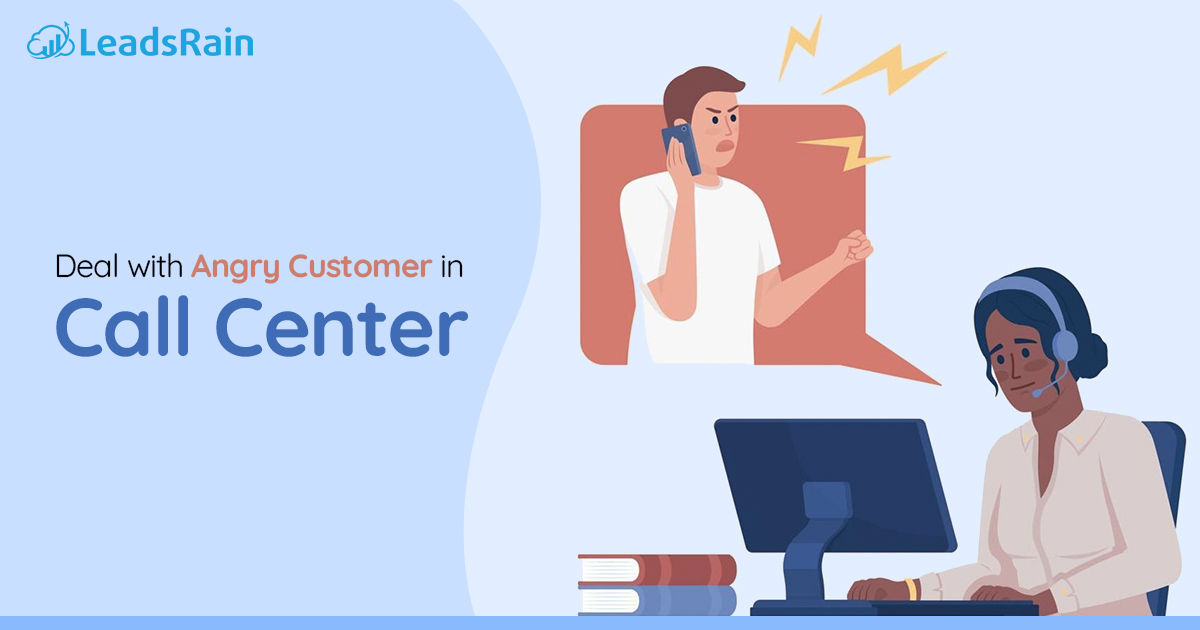How to handle angry customers in a call center
 Jay T
Jay T
Dealing with angry customers can be a challenging task, especially in a call center environment where emotions can run high. However, with the right approach and techniques, it is possible to turn a negative customer experience into a positive one. So, let’s explore some effective techniques for handling frustrated customers in a contact center and provide some post-interaction follow-ups, so you can ensure customer satisfaction and maintain a positive brand image.
Importance of handling angry customers effectively
Handling angry customers effectively in a contact center is of utmost importance for maintaining customer satisfaction and fostering positive relationships. When customers reach out with frustration or anger, calling center agents must handle these situations skillfully and empathetically.
Research shows that customers who have their issues resolved effectively are more likely to remain loyal to a brand. By adopting a patient, empathetic and solution-oriented approach, call center agents can transform negative interactions into positive ones, benefiting both the customer and the company.
Understanding Customer Anger
Customer anger is a common occurrence in the calling center industry, and they must understand the factors contributing to this emotion. By understanding the triggers, emotions, previous negative experiences, and expectations of angry customers, call centers can approach interactions with empathy and find appropriate solutions. Let’s have a look at some common scenarios that contact center professionals may encounter when dealing with frustrated customers.
Scenario 1: A customer is frustrated because their product arrived damaged.
Solution: The contact center agent actively listens to the customer’s concerns and expresses empathy. They apologize for the inconvenience and assure the customer that they will arrange for a replacement to be sent immediately. The agent follows up with the customer to ensure the replacement was received in good condition.
Scenario 2: A customer is upset about a billing error and demands a refund.
Solution: The agent remains calm and validates the customer’s frustration. They apologize for the error and explain that they will investigate the issue. The agent assures the customer that they will resolve the billing error promptly and issue a refund, providing a timeline for when the refund will be processed. They follow up with the customer after a refund has been issued to confirm its completion.
Scenario 3: A customer is angry due to a service outage that has disrupted their business operations.
Solution: The agents at the calling center actively listen to the customer’s concerns and acknowledge the impact of the service outage. They apologize for the inconvenience and explain that the technical team is currently working on resolving the issue. The agent regularly updates the customer on the progress and estimated restoration time. They offer alternative solutions or workarounds to minimize the impact on the customer’s business.
Scenario 4: A customer is dissatisfied with the resolution provided by a previous interaction with the call center.
Solution: The contact agents listen attentively to the customer’s concerns and validate their dissatisfaction. They apologize for the previous experience and take ownership of the issue. The agent offers a personalized solution, such as a discount or additional service, to compensate for customer dissatisfaction. They closely follow up with the customer to ensure the new resolution meets their expectations.
The Untapped benefits of handling angry customers in call centers
What if I told you that there are significant benefits to be gained from successfully managing these difficult interactions? While it may be tempting to avoid confrontations altogether, addressing and resolving customer anger can lead to long-lasting positive outcomes for both the customer and the calling center. So, let's delve into various benefits that come from handling frustrated customers effectively.
Customer retention. By effectively addressing and resolving the concerns of angry customers, you have a higher chance of retaining their business. Customers who feel heard, understood, and satisfied with the resolution are more likely to remain loyal to your company, leading to long-term customer retention.
Positive word-of-mouth. Satisfied customers are more likely to share positive experiences with others, whether through word-of-mouth or online reviews. Handling angry customers well allows you to turn a negative situation into a positive one. This can lead to positive word-of-mouth recommendations, attracting new customers to your business.
Enhanced brand reputation. When customers see that your contact center is capable of dealing and resolving difficult situations with professionalism and empathy, it enhances your brand’s reputation. A strong reputation for excellent customer service can differentiate your company from competitors and attract more customers.
Improved customer satisfaction. Effective handling of frustrated customers results in increased customer satisfaction. When customers feel that their concerns have been acknowledged and resolved promptly and effectively, they are more likely to feel satisfied with their overall experience. Satisfied customers are more likely to become repeat customers and advocates for your brand.
Opportunity for improvement. Angry customers provide valuable feedback that can highlight areas for improvement within your calling industry or your organization as a whole. By actively listening to their concerns and addressing them, you gain insights into potential gaps or issues in your products, services, or processes. This can guide you in making necessary improvements to prevent similar issues in the future and enhance the customer experience overall.
Techniques for calming an angry customer
When faced with an angry customer, contact centers need to handle the situation calmly and effectively. By employing these techniques, calling centers can maintain positive customer relationships. Here are some techniques to help calm an angry customer:
Stay calm. By maintaining a calm demeanor, you can help defuse the customer’s anger and create a more positive atmosphere. It is natural for customers to vent their frustrations, but as contact agents, we must refrain from becoming defensive or engaging in a heated argument. Instead, we should respond with a calm and composed demeanor, using a polite and respectful tone throughout the conversation.
Active listening. When dealing with an angry customer, it is crucial to engage in active listening. This means giving the customer your full attention, avoiding interrupting, and allowing them to express their frustrations. By actively listening, we not only gather important information about the issue but also make the customer feel heard and understood.
Validate their concerns. Validate the customer’s feelings and concerns by acknowledging their frustration and empathizing with their situation. Use phrases such as “I understand how frustrating this must be for you” or “ I’m sorry you’ve had this experience”.
Take ownership and offer solutions. After understanding the customer’s problem and expressing empathy, it is time to offer solutions. Agents in the caller center should take the initiative to resolve the issue by providing appropriate options or escalating the matter to a supervisor if necessary. Promptly following through on promises helps rebuild customer trust and satisfaction.
Provide timely updates. Keeping the customer informed about the progress of their concern is crucial in managing their anger. Regularly update them on the steps you are taking to resolve the problem and the timeline involved. Avoid leaving the customer in the dark, as this can lead to frustration and increased anger.
Use positive language. The language you use when speaking with an angry customer can have a significant impact on their emotional state. Choose your words wisely, opting for positive and polite language. Avoid using negative or confrontational phrases, as this may exacerbate the customer’s anger.
Follow up. After resolving the issue, follow up with the customer to ensure their satisfaction. This gesture shows that you value their feedback and reinforces the importance of their experience with your company.
Optimize technology. Using technology can also help employees handle customer calls more successfully. Technology has made it possible to fix every problem. Dealing with angry and unhappy customers is a necessary aspect of the job. For example, call center software solutions with live monitoring and call recording features may assist management in teaching operators how to handle angry clients.
Post interaction follow-ups
Dealing with angry customers is a part of the job when working in a calling center. However, the job doesn’t end with simply addressing their immediate concerns. Following up with angry customers after the initial interaction is crucial for building trust and maintaining positive relationships. Let’s find out these 5 post-interaction follow-ups that are effective in handling angry customers in a contact industry.
Thank them for their feedback
Dealing with angry customers can be demanding, but going the extra mile in post-interaction follow-ups can make a huge difference. Firstly, expressing gratitude for their feedback shows that you respect their opinion and value their input. By thanking them, you establish a positive tone for the follow-up communication. Remember, customers who take the time to give feedback often want to see an improvement and feel heard.
Provide a progress update
After expressing gratitude, providing a progress update is essential. This helps the customer stay informed and assures them that their complaint has not been ignored. Transparency is vital here; let the customer know the steps taken to resolve their issue, any challenges you might be facing, and progress made toward finding a solution. This helps build trust and creates a sense of partnership in resolving the problem.
Offer a solution or compensation
In some cases, simply addressing the issue may not be enough. Offering a solution or compensation can further demonstrate your commitment to customer satisfaction. Provide the customer with options or alternatives that fit their needs, and show that you are willing to go the extra mile to make things right. Compensation or gestures of goodwill can be particularly effective in retaining customer loyalty and turning a negative experience into a positive one.
Ask for their input
In addition to providing a solution, inviting the customer’s input can also help in dealing with angry customers. Asking for their suggestions on how to improve the resolution process shows that you value their opinions and are dedicated to enhancing the customer experience. Customers appreciate being included in the problem-solving process and knowing that their feedback contributes to positive change.
Check-in after the resolution
Finally, checking in with the customer after the resolution ensures their satisfaction and reinforces their importance. By reaching out after resolving the issue, you show that you care about their experience even beyond the initial interaction. This step helps solidify the relationship and leaves a lasting positive impression.
Conclusion
Handling frustrated clients in a caller’s center requires a blend of empathy, professionalism, and effective communication skills. By understanding the customer’s anger, remaining calm and professional, actively listening, offering solutions, and providing timely updates, call center agents can turn challenging conversations into positive experiences. Remember, each interaction with an angry customer is an opportunity to showcase exceptional customer service and build customer loyalty.
Subscribe to my newsletter
Read articles from Jay T directly inside your inbox. Subscribe to the newsletter, and don't miss out.
Written by
